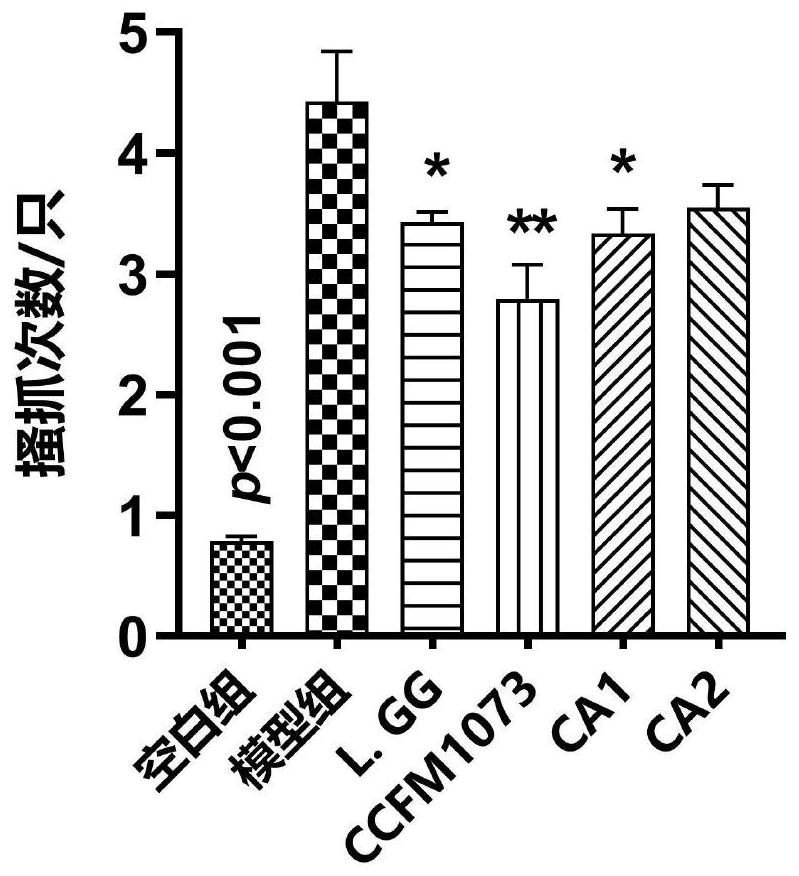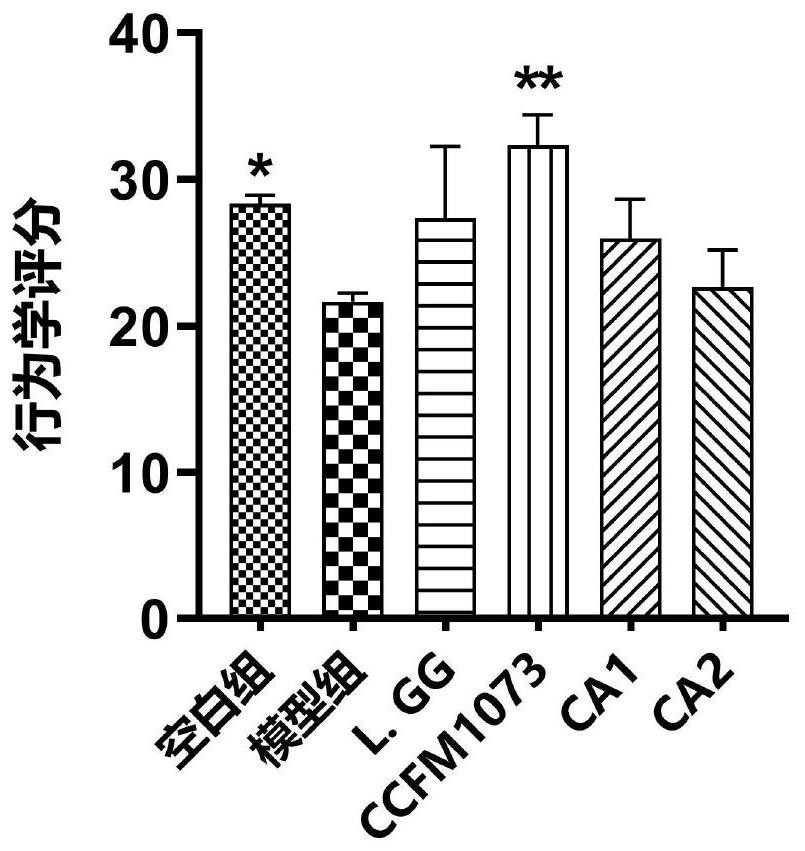Product for preventing and/or treating atopic dermatitis
A technology for atopic dermatitis and products, applied in the field of microorganisms, can solve problems such as adverse reactions, poor tolerance of patients, and difficulties in the treatment of atopic dermatitis
- Summary
- Abstract
- Description
- Claims
- Application Information
AI Technical Summary
Problems solved by technology
Method used
Image
Examples
Embodiment 1
[0055] Example 1: Effects of Different Lactobacillus casei on the Number of Scratchings in Atopic Dermatitis Mice
[0056] 36 6-week-old SPF (specific pathogen free) grade C57BL / 6 female mice were randomly divided into 6 groups, 6 mice in each group, and the 6 groups were: blank group, model group, positive reference group and three groups of cheese milk Bacillus experimental group, wherein, the positive reference group is the L.GG group of Lactobacillus rhamnosus GG, the three groups of Lactobacillus casei experimental groups are the CCFM1073 group of Lactobacillus casei CCFM1073, and the Lactobacillus casei 1 group. CA1 group and CA2 group fed with Lactobacillus casei 2. All mice were housed in an SPF barrier and had free access to food and water.
[0057] The experiment lasted for four weeks: the first week was the adaptation period of the mice; the second week began to gavage the mice until the end of the experiment. Lactobacillus 1, Lactobacillus casei 2 bacteria soluti...
Embodiment 2
[0060] Example 2: Effects of different Lactobacillus casei on behavioral indicators of atopic dermatitis mice
[0061] 36 6-week-old SPF (specific pathogen free) grade C57BL / 6 female mice were randomly divided into 6 groups, 6 mice in each group, and the 6 groups were: blank group, model group, positive reference group and three groups of cheese milk Bacillus experimental group, wherein, the positive reference group is the L.GG group of Lactobacillus rhamnosus GG, the three groups of Lactobacillus casei experimental groups are the CCFM1073 group of Lactobacillus casei CCFM1073, and the Lactobacillus casei 1 group. CA1 group and CA2 group fed with Lactobacillus casei 2. All mice were housed in an SPF barrier and had free access to food and water.
[0062] The experiment lasted for four weeks: the first week was the adaptation period of the mice; the second week began to gavage the mice until the end of the experiment. Lactobacillus 1, Lactobacillus casei 2 bacteria solution, ...
Embodiment 3
[0065] Embodiment 3: Effects of different Lactobacillus casei on ear thickness of atopic dermatitis mice
[0066] 36 6-week-old SPF (specific pathogen free) grade C57BL / 6 female mice were randomly divided into 6 groups, 6 mice in each group, and the 6 groups were: blank group, model group, positive reference group and three groups of cheese milk Bacillus experimental group, wherein, the positive reference group is the L.GG group of Lactobacillus rhamnosus GG, the three groups of Lactobacillus casei experimental groups are the CCFM1073 group of Lactobacillus casei CCFM1073, and the Lactobacillus casei 1 group. CA1 group and CA2 group fed with Lactobacillus casei 2. All mice were housed in an SPF barrier and had free access to food and water.
[0067] The experiment lasted for four weeks: the first week was the adaptation period of the mice; the second week began to gavage the mice until the end of the experiment. Lactobacillus 1, Lactobacillus casei 2 bacteria solution, with ...
PUM
 Login to View More
Login to View More Abstract
Description
Claims
Application Information
 Login to View More
Login to View More - R&D
- Intellectual Property
- Life Sciences
- Materials
- Tech Scout
- Unparalleled Data Quality
- Higher Quality Content
- 60% Fewer Hallucinations
Browse by: Latest US Patents, China's latest patents, Technical Efficacy Thesaurus, Application Domain, Technology Topic, Popular Technical Reports.
© 2025 PatSnap. All rights reserved.Legal|Privacy policy|Modern Slavery Act Transparency Statement|Sitemap|About US| Contact US: help@patsnap.com



